Some horsemen on rearing horses can be associated with the milestones in general history or in the history of arts.
Painting Styles
↑ Back To Table Of Contents ↑

ROMANESQUE ARTHunt of the Hare, fresco painting on mural transferred to canvas, cr. 1125, Hermitage of San Baudelio, Casillas de Berlanga, Soria, Spain

INTERNATIONAL GOTHICSaint George Killing the Dragon, 1434-5, Bernat Martorell, Barcelona, modern-day Spain
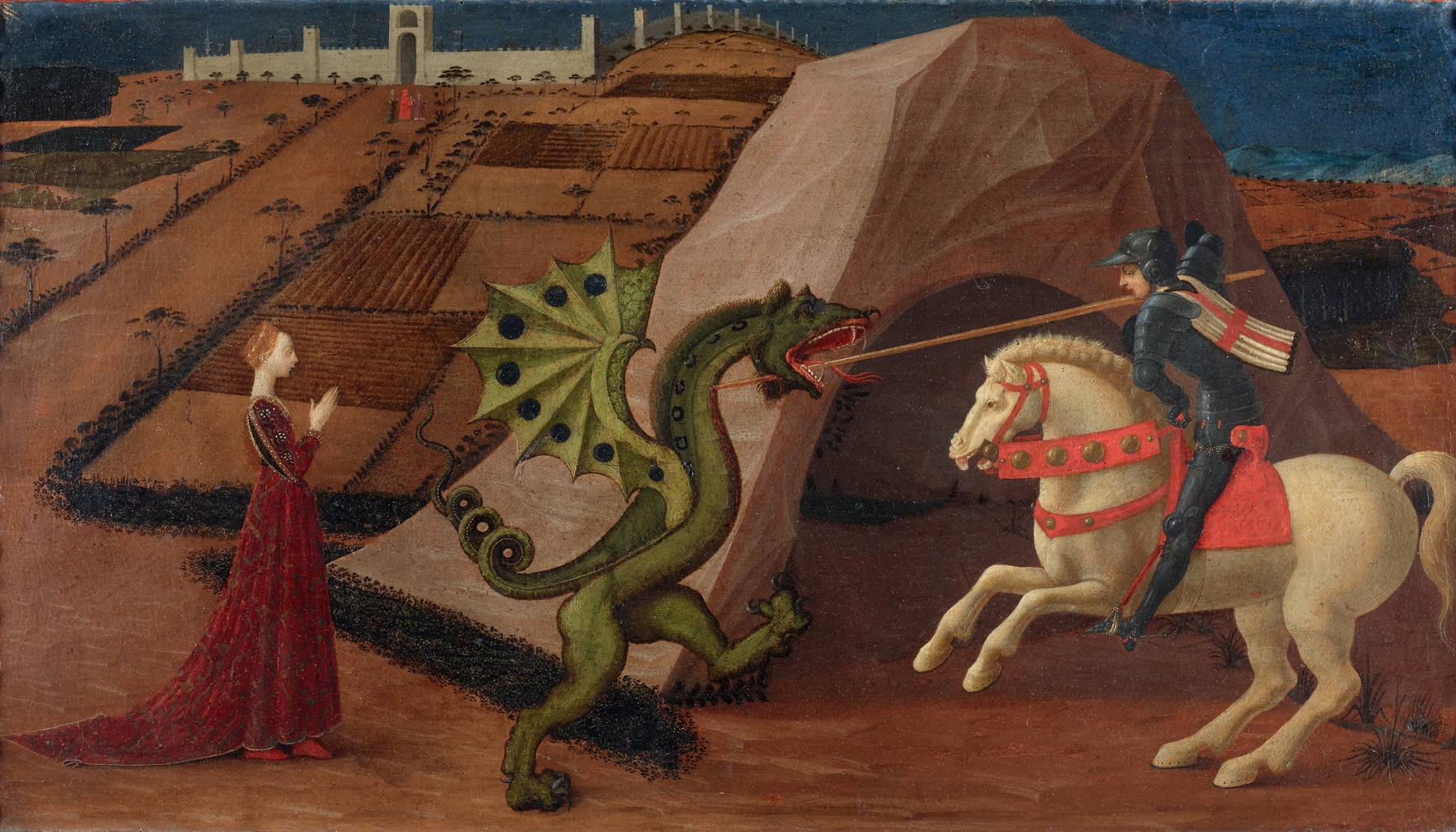
EARLY RENAISSANCESt. George and the Dragon, cr. 1430-35, Paolo Uccello, Florence, Italy

EARLY NETHERLANDISH PAINTINGSaint George and the Dragon, circa 1432-5, Rogier van der Weyden, Netherlandish (present-day Belgium and France)

SIENESE SCHOOLSaint George and The Dragon, 1444, Sano di Pietro, Siena, Italy

MANNERISMSaint George and The Dragon, 1581, Gillis Coignet, Flemish school

BAROQUESt George Fighting the Dragon, 1606-10, Peter Paul Rubens

ROCOCOThe Force of Eloquence, cr. 1723, Giovanni Battista Tiepolo, Venice, Italy

NEOCLASSICISMNapoleon Crossing the Alps, 1802, Jacques-Louis David

ROMANTICISMArab Horseman Attacked by a Lion, 1849-50, Delacroix Eugène, France

SYMBOLISM (ARTS)Saint George and the dragon, 1889-90, Gustave Moreau, Paris, France
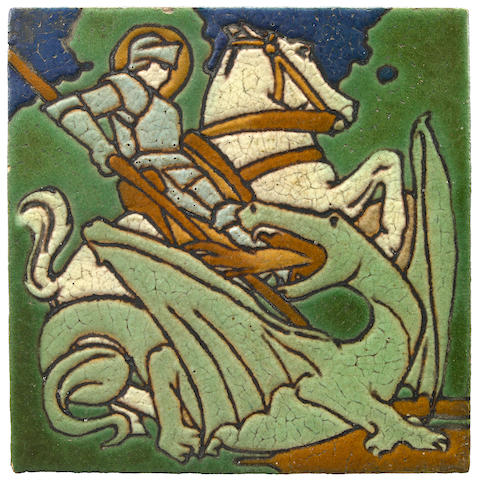
ARTS AND CRAFTSCuenca and cuerda seca floor tile depicting St George and the dragon, cr. 1900, Grueby Faience Company, U.S.A.

ART NOUVEAUSaint George killing the dragon, colour lithograph (a postcard), 1908, J.Jílovský, Prague, Austro-Hungarian Empire

ART DECOA WWI British recruitment poster No. 108, 1915, England
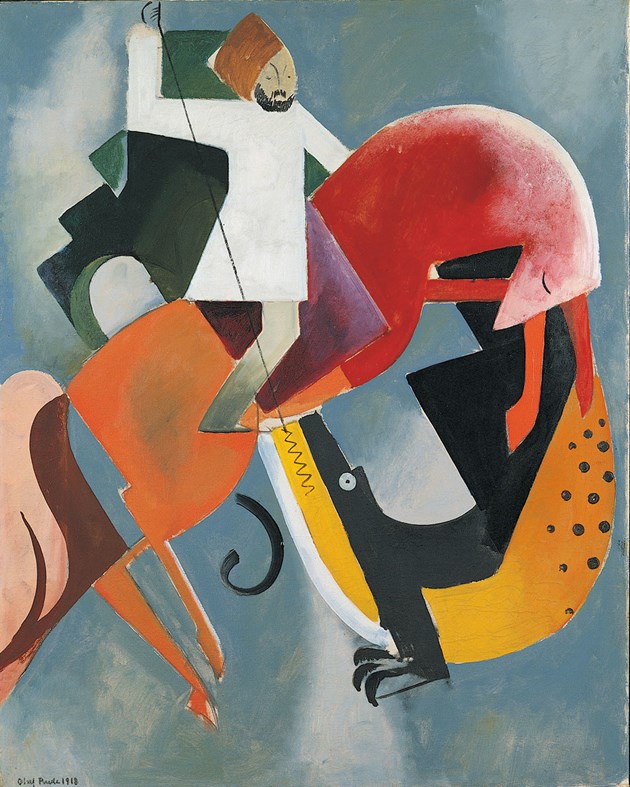
MODERNISMSaint George and the dragon, 1918, Olaf Rude, Denmark
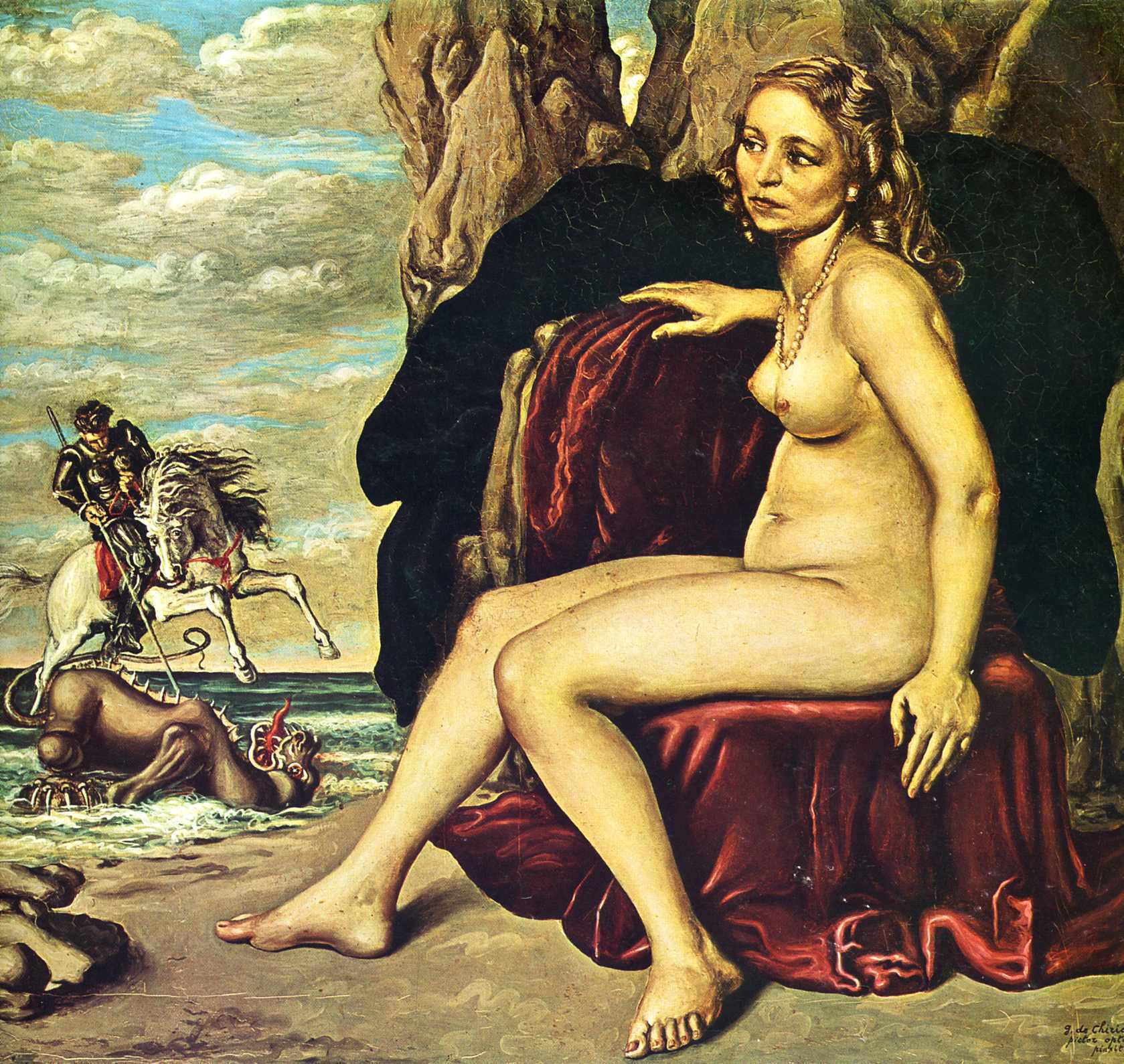
SURREALISMSt. George Killing the Dragon, 1940, Giorgio de Chirico, Italy

POP ARTKnight of Cups, 1984, Universal Tarot deck, Salvador Dalí
Painting Techniques
↑ Back To Table Of Contents ↑
1420s- 1430s, Florence: Discovery of the mathematics of linear perspective
↑ Back To Table Of Contents ↑

COMPARANDUM: Hunt of the Hare, fresco painting on mural transferred to canvas, cr. 1125, Hermitage of San Baudelio, Casillas de Berlanga, Soria, Spain

COMPARANDUM: Miracle of St George and the Dragon, with Scenes from his Life., 1300-50, Novgorod, Russia
Earlier European paintings were flat, the size of the figures was often dictated by their importance rather than what they could possibly look like in reality. In cr. 1420
Filippo Brunelleschi, a Florentine architect, has discovered the mathematical laws of
linear perspective, and it was widely adopted soon after.
Perspective was fascinating many great minds of the time. Paolo Uccello was particularly passionate about it. He would “stand the whole night through beside his writing desk seeking new terms for the expression of his rules of perspective.” When his missus asked him to come to bed Paolo would often decline, saying he had plans with “my sweet mistress perspective.”
Later, in the 1470s-1480s, Piero della Francesca has written De Prospectiva pingendi (On the Perspective of painting), the earliest and only pre-1500 Renaissance treatise solely devoted to the subject of perspective.

Saint George and the Dragon, circa 1432-5, Rogier van der Weyden, Netherlandish (present-day Belgium and France)

St. George and the Dragon, cr. 1430-35, Paolo Uccello, Florence, Italy
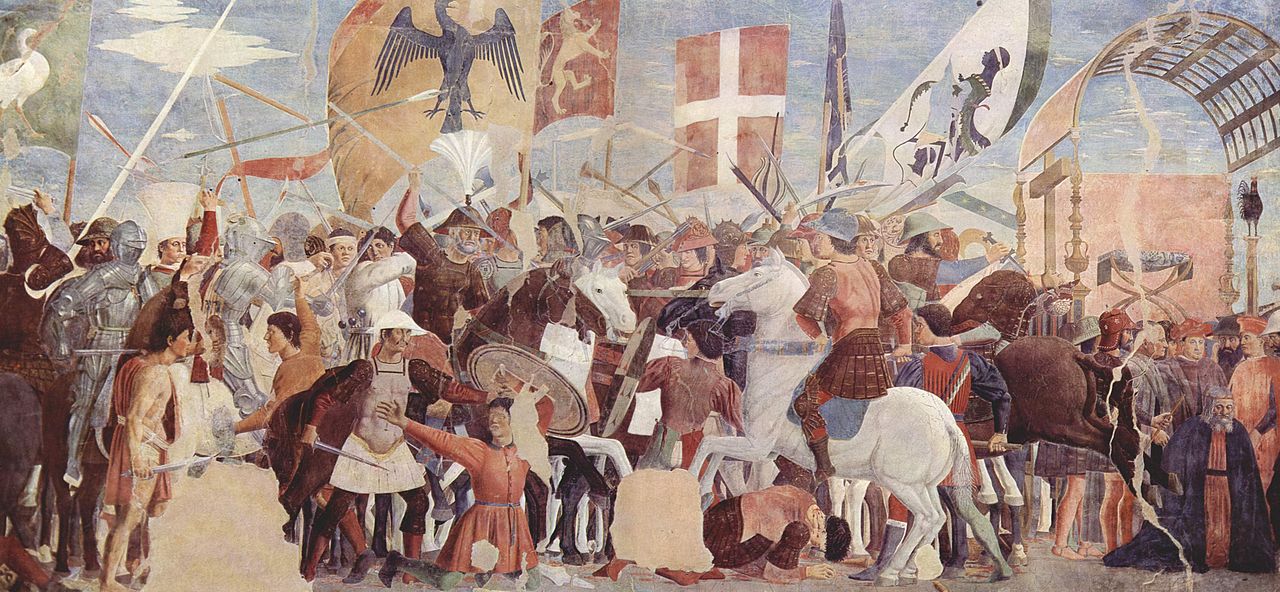
The Battle of Nineveh (between Khosrau II and Heraclius, in 627), cr. 1452-66, Piero della Francesca, Arezzo, Italy
15th century, Netherlands: widespread adoption of oil paints
↑ Back To Table Of Contents ↑

Saint George and the Dragon, circa 1432-5, Rogier van der Weyden, Netherlandish (present-day Belgium and France)

The Adoration of the Magi, 1480-2, Leonardo da Vinci
Earlier European paintins were done using
tempera, a mix of egg yolk and pigments. Resulting paintings are very long-lasting, but tempera is difficult to work with, and it has some technical limitations, e.g. creating translucent layers is not possible.
The beginnings of oil painting are recorded as early as the twelfth century in Northern Europe. But it was the virtuoso handling of the medium on panel by early Netherlandish painters such as Jan van Eyck and Rogier van der Weyden that represented a turning point in its eventual adoption as the major painting medium in Europe in the sixteenth century. By then, Jan van Eyck had been incorrectly credited with the “invention” of oil painting.
In Italy, Leonardo da Vinci was among the first adopters of oil paints.
Mid-16th century, Venice: adoption of canvas as painting support
↑ Back To Table Of Contents ↑

Equestrian Portrait of Charles V at the battle of Mühlberg, 1548, Titian, Augsburg, Germany

The sacrificial death of Marcus Curtius, 1550-2, Paolo Veronese, Venice, Italy
The earlier European paintings were done on wood.
The use of canvas as a support for oil paints allowed for easier transport of larger compositions, canvas is far lighter than oak panels, also a painting executed on canvas can be rolled up and transported more easily than wooden panels. Canvas became prominent in the Italian Renaissance and it was widely used, particularly in Venice.
Venice was a wealthy trading port and, in the many workshops within the city, produced sails made from linen and other fabrics. In fine art, linen is still considered to be the finest support for oil painting. Later examples of oil paintings from the Venetian painters include works by Paolo Veronese and Titian.
Funeral Monuments With Horsemen On Rearing Horses
↑ Back To Table Of Contents ↑
Funeral monuments, big or small, were very important to people throughout history.
Cinerary Urns
↑ Back To Table Of Contents ↑
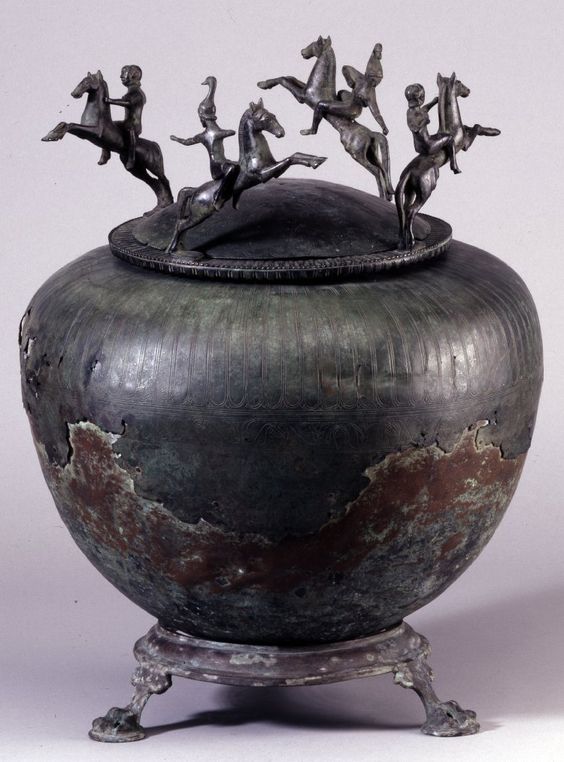
Bronze cinerary urn with lid, cr. 500 BC (?), Etruscan
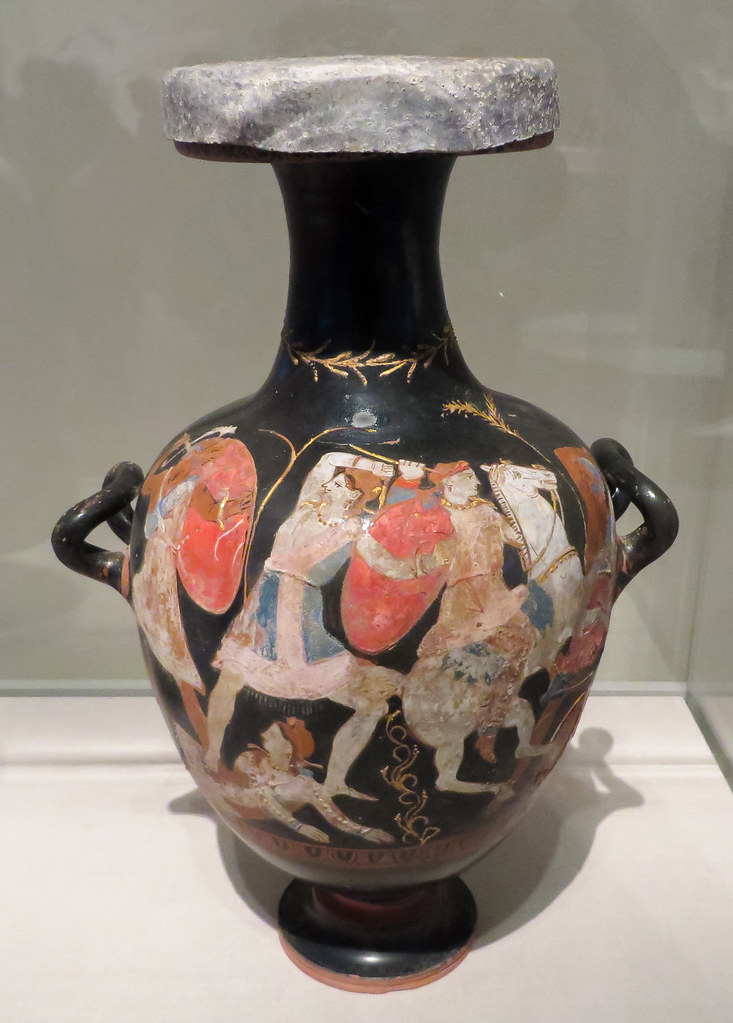
Terracotta hydria showing battle of Greeks and Amazons (Amazonomachy), cr. 325-300 BC, Attic style, Kastri (Amphipolis), Central Macedonia, Greece

Krater showing the Duel of Life and Death (Etruscan symbolism), cr. 320-280 BC, Canosa, Apulia
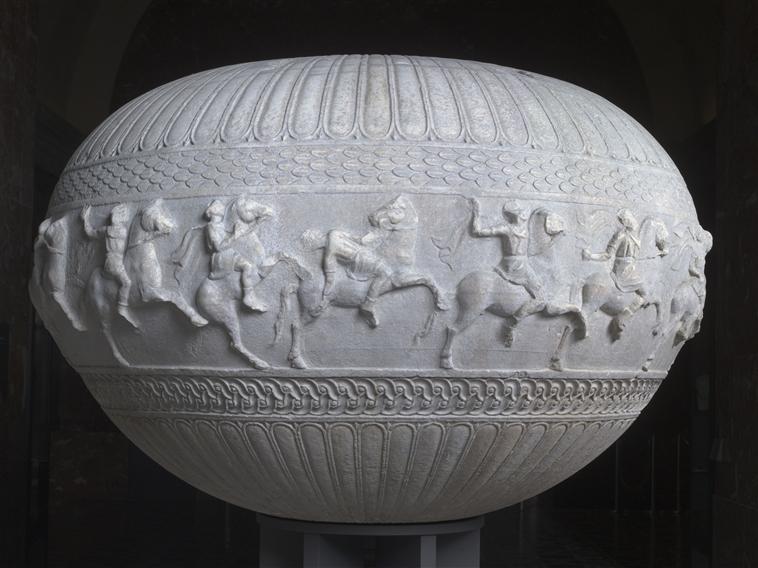
Pergamon vase, a marble dinos with a depiction of 15 horsemen, 2nd century BC, Bergama, Turkey
Gravestones
↑ Back To Table Of Contents ↑
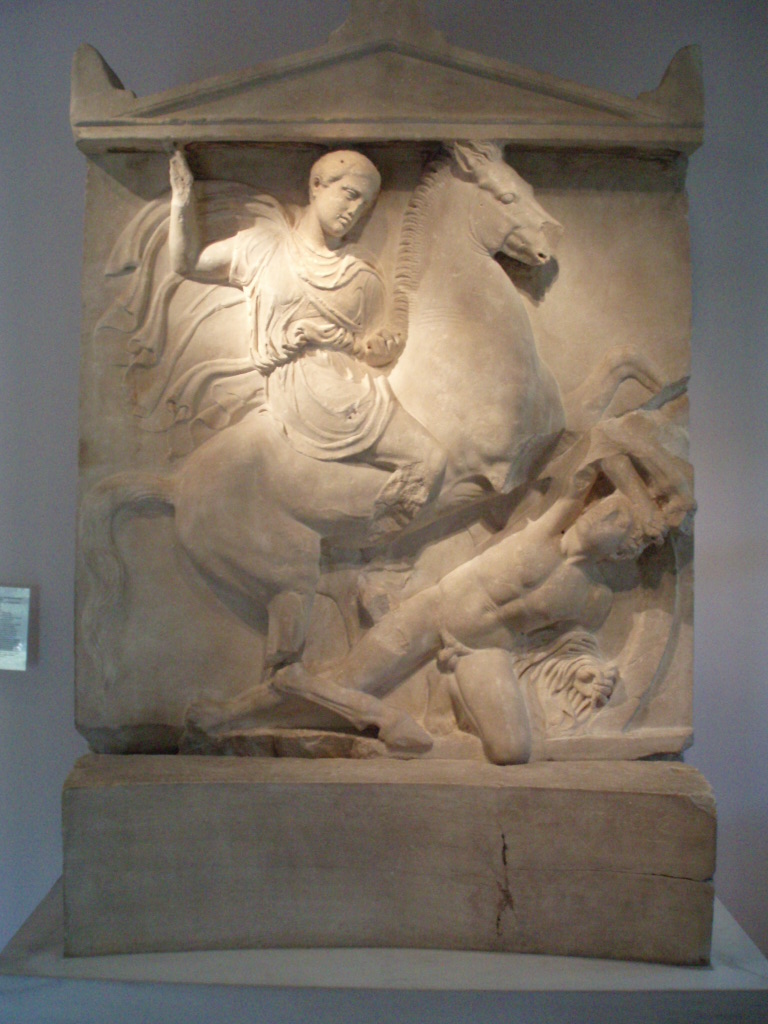
Tomb sculpture of Dexileos, cr. 394 BC, Attic
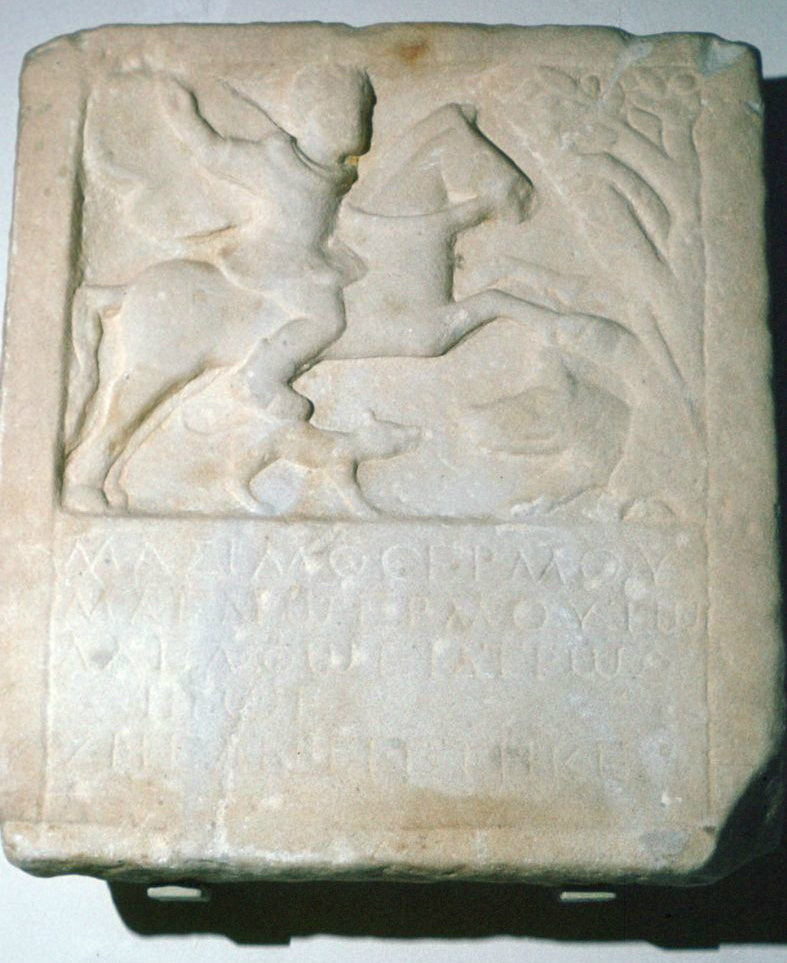
Tombstone with Thracian rider relief, 1st - 2nd century AD
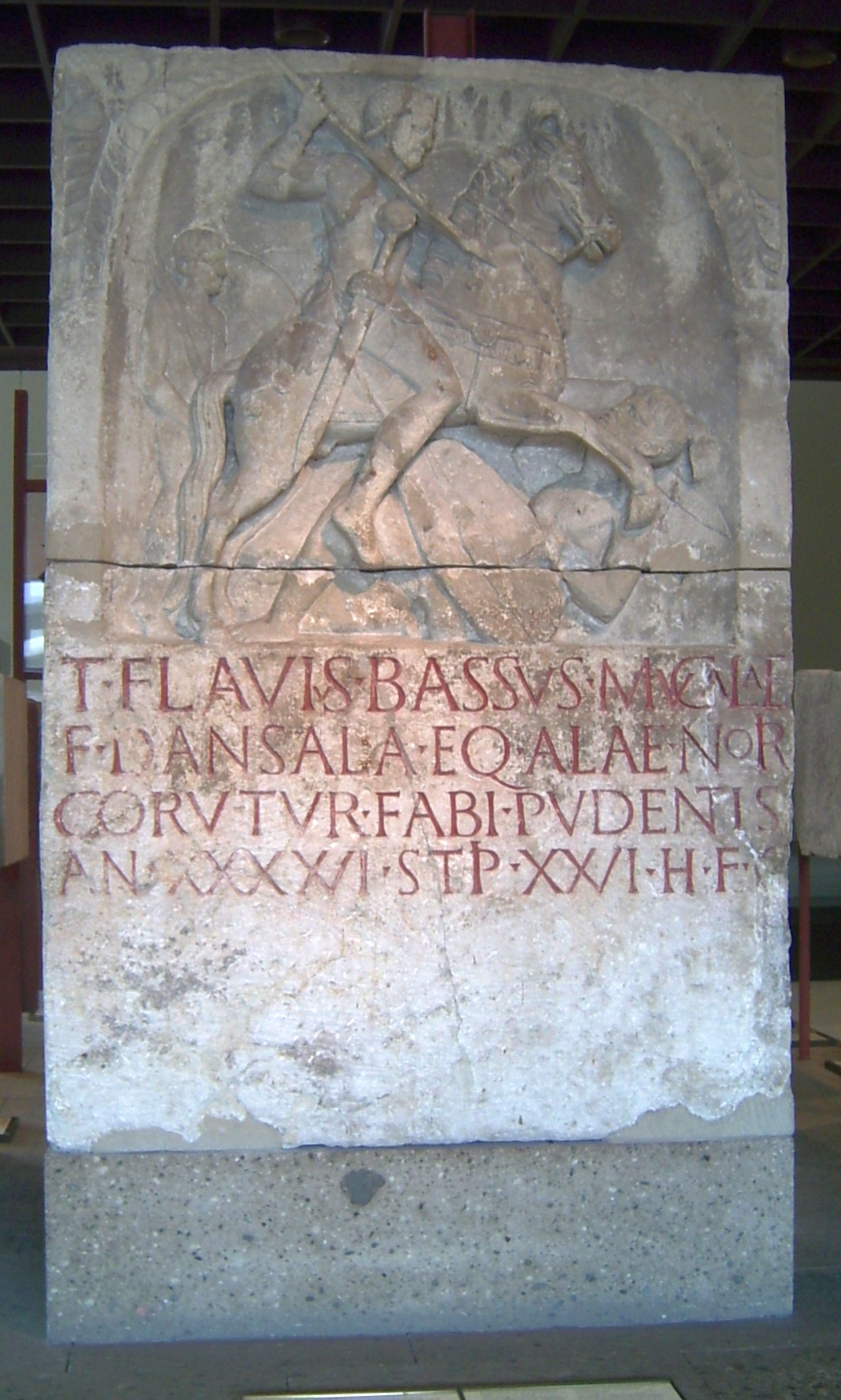
Tombstone for Roman cavalryman Titus Flavius Bassus, 1st century AD, discovered in Cologne, Germany
Sarcophagi
↑ Back To Table Of Contents ↑
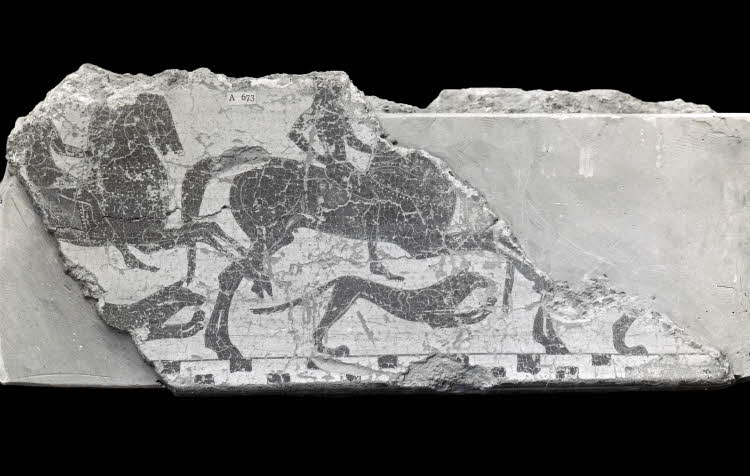
Fragment of Klazomenian painted terracotta sarcophagus with youths riding horses below which run dogs, late 6th century BC, Klazomenian (modern Turkey)

Lycian sarcophagus, end of 5th century BC, Chamber no. IV of the royal necropolis of Sidon, modern Lebanon

The Çan Sarcophagus, 400-375 BC, village of Altıkulaç, near Çan, modern-day Turkey
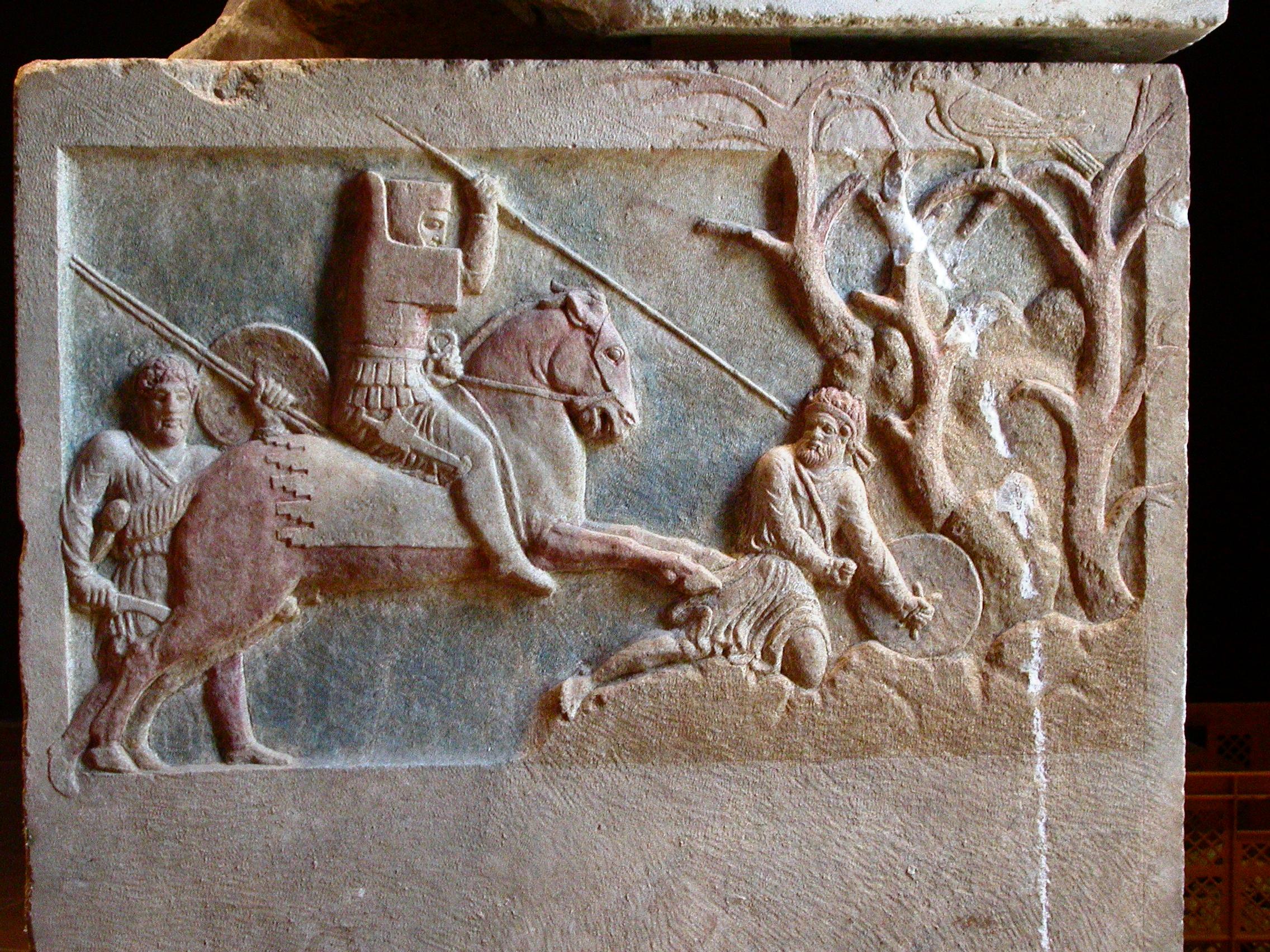
The Çan Sarcophagus, detail of Persian horseman spearing fallen footsoldier, 400-375 BC, village of Altıkulaç, near Çan, modern-day Turkey

Sarcophagus and lid with husband and wife with two pairs of horsemen and foot soldiers in combat, 350–300 BC, Italian/Etruscan

Alexander sarcophagus, long side showing a lion hunt, with (l-r) Hephaestion, Abdalonymos and Alexander the Great, circa 320 BC, Ionian or Rhodian workmanchip, Hellenistic

Sarcophagus with an Amazonomachy scene, 2nd century, Thessaloniki
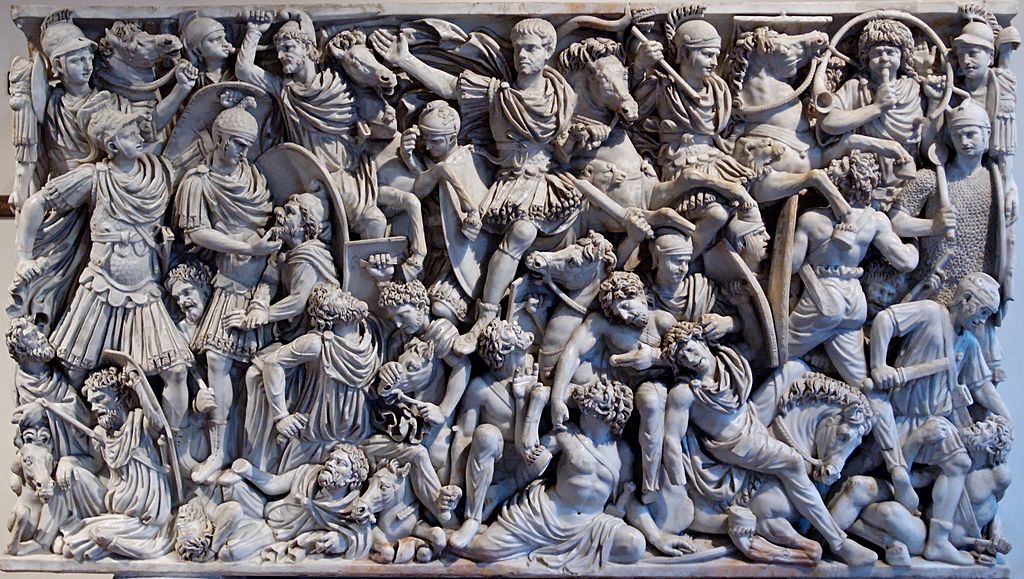
Ludovisi Battle sarcophagus showing a battle scene between Roman soldiers and Goths, cr. 250–260, Rome
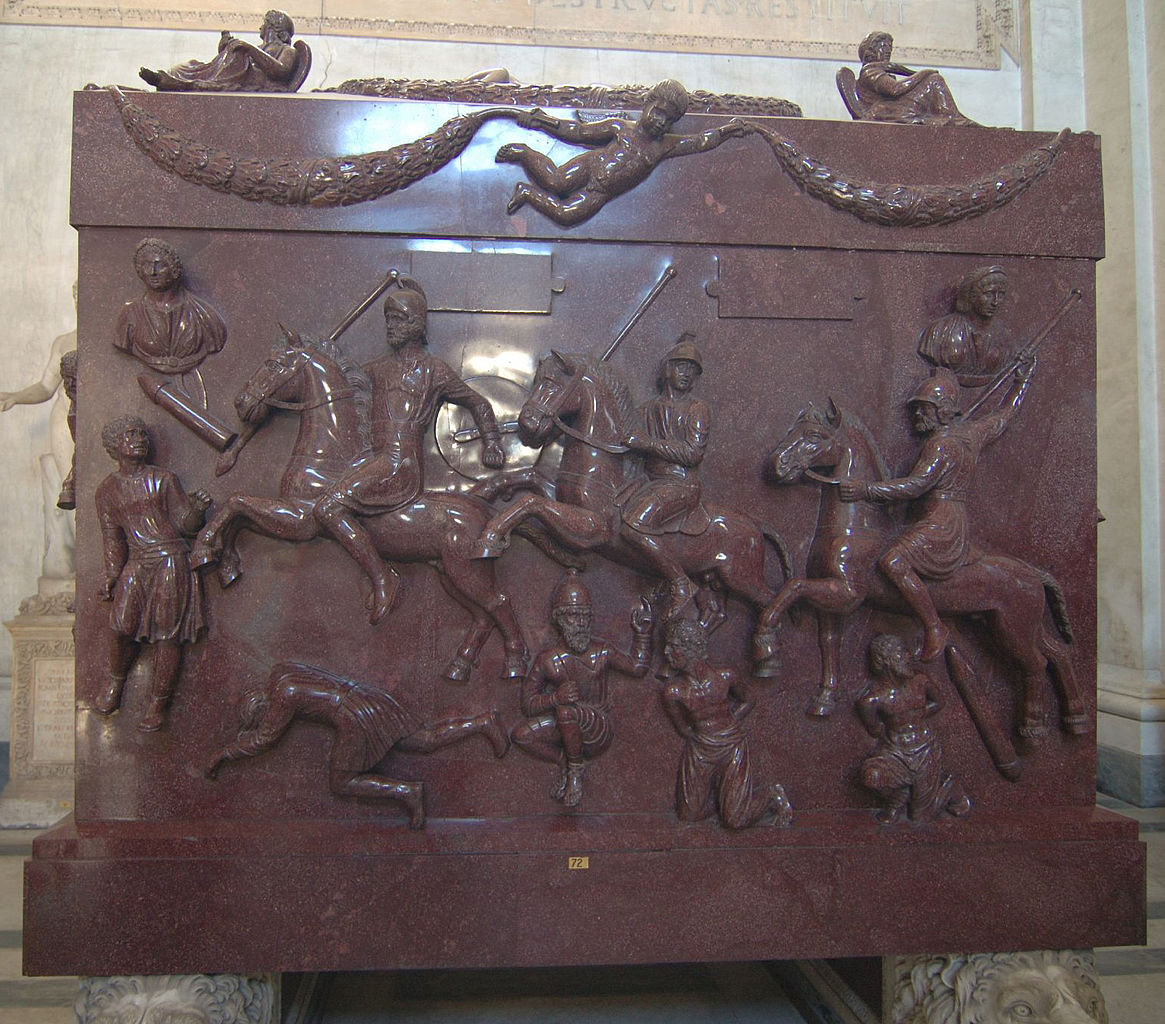
Sarcophagus of Saint Helena, cr. 340, Rome
Mausoleums
↑ Back To Table Of Contents ↑
There were a few large scale funeral monuments: mausoleums, temple tombs and a necropolis that featured horsemen on rearing horses.
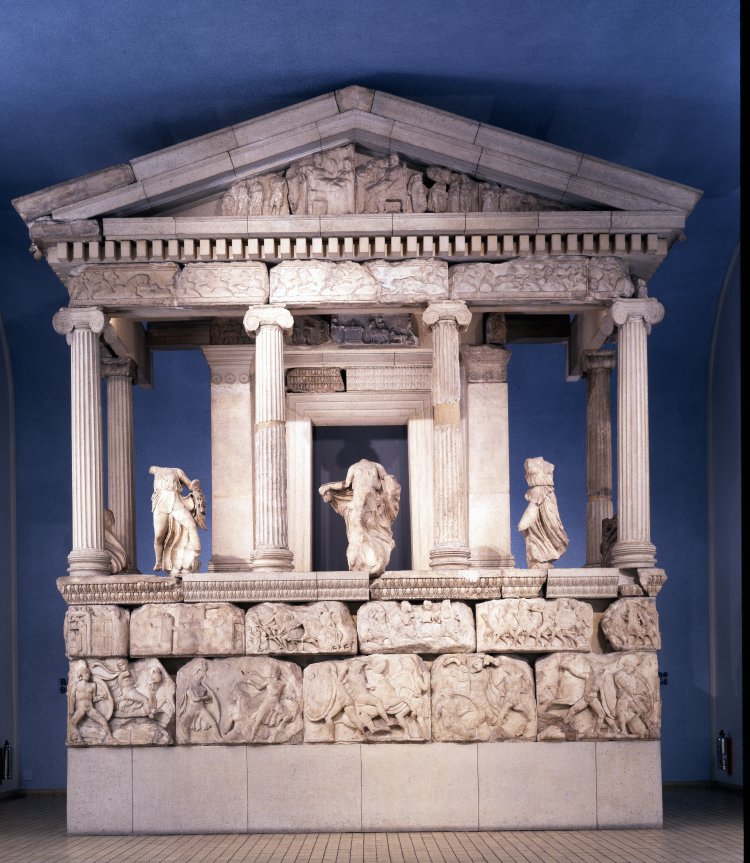
The reconstructed façade of the Nereid Monument, cr. 390-380 BC, classical Greek, Xanthos in Lycia, close to present-day Fethiye in Mugla Province, Turkey
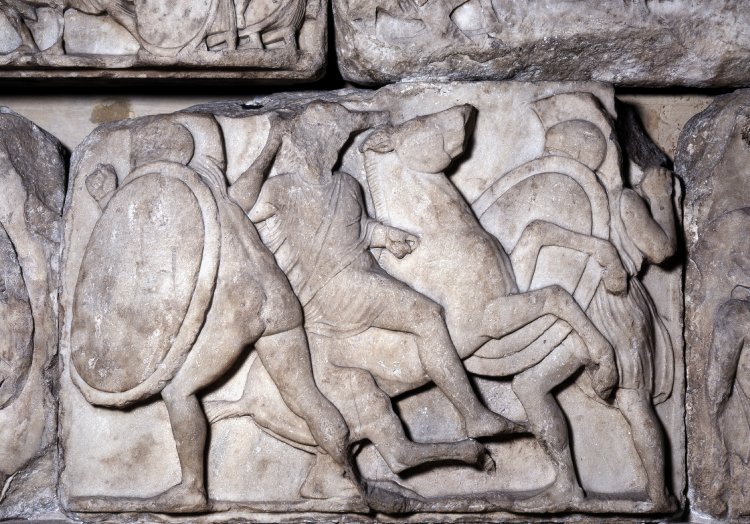
Detail of the first frieze of the Nereid monument showing heroic combats, cr. 390-380 BC, classical Greek, Xanthos in Lycia, close to present-day Fethiye in Mugla Province, Turkey
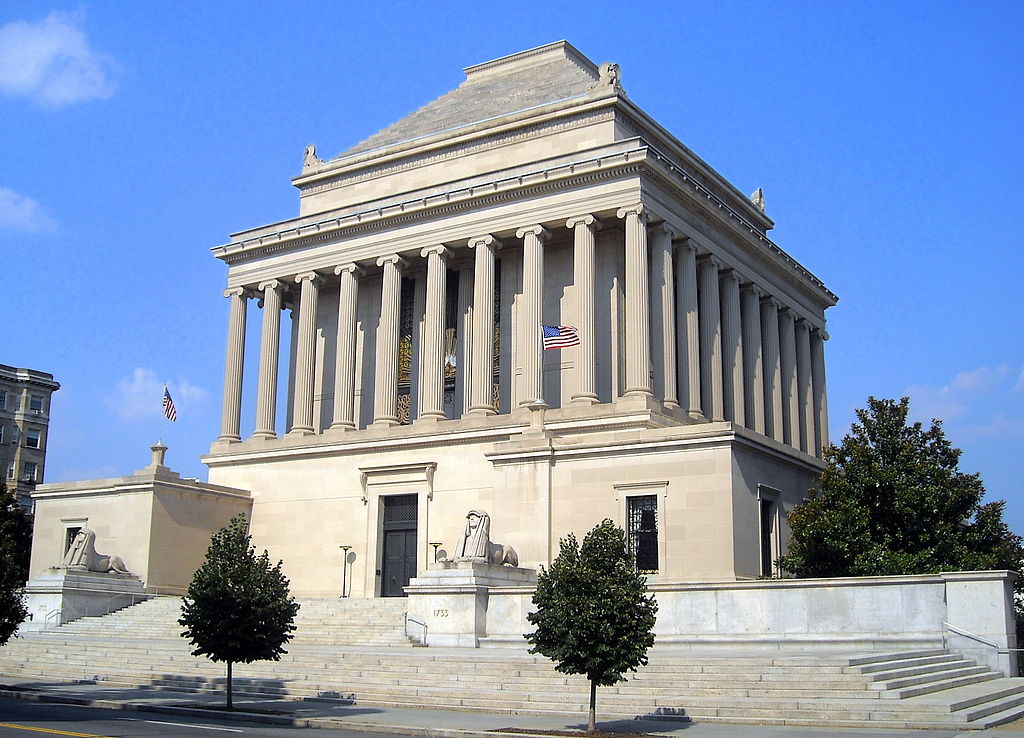
House of the Temple, design based on the Mausoleum at Halicarnassus, 1911-5, Washington, D.C., U.S.A.
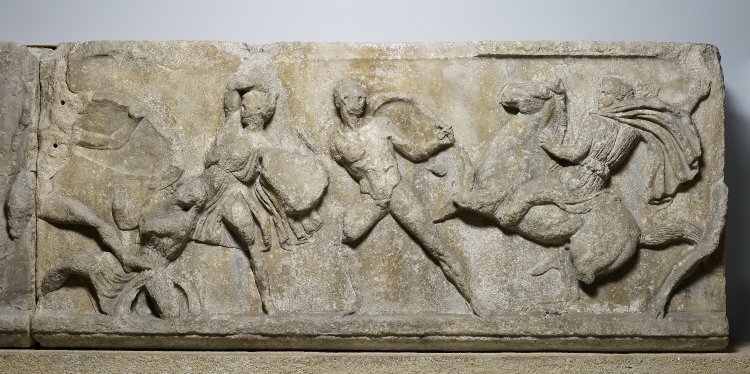
Detail of the Amazon Frieze of the Mausoleum at Halicarnassus, cr. 350 BC, Pytheos (?), classical Greek, Halicarnassus (present Bodrum, Turkey)
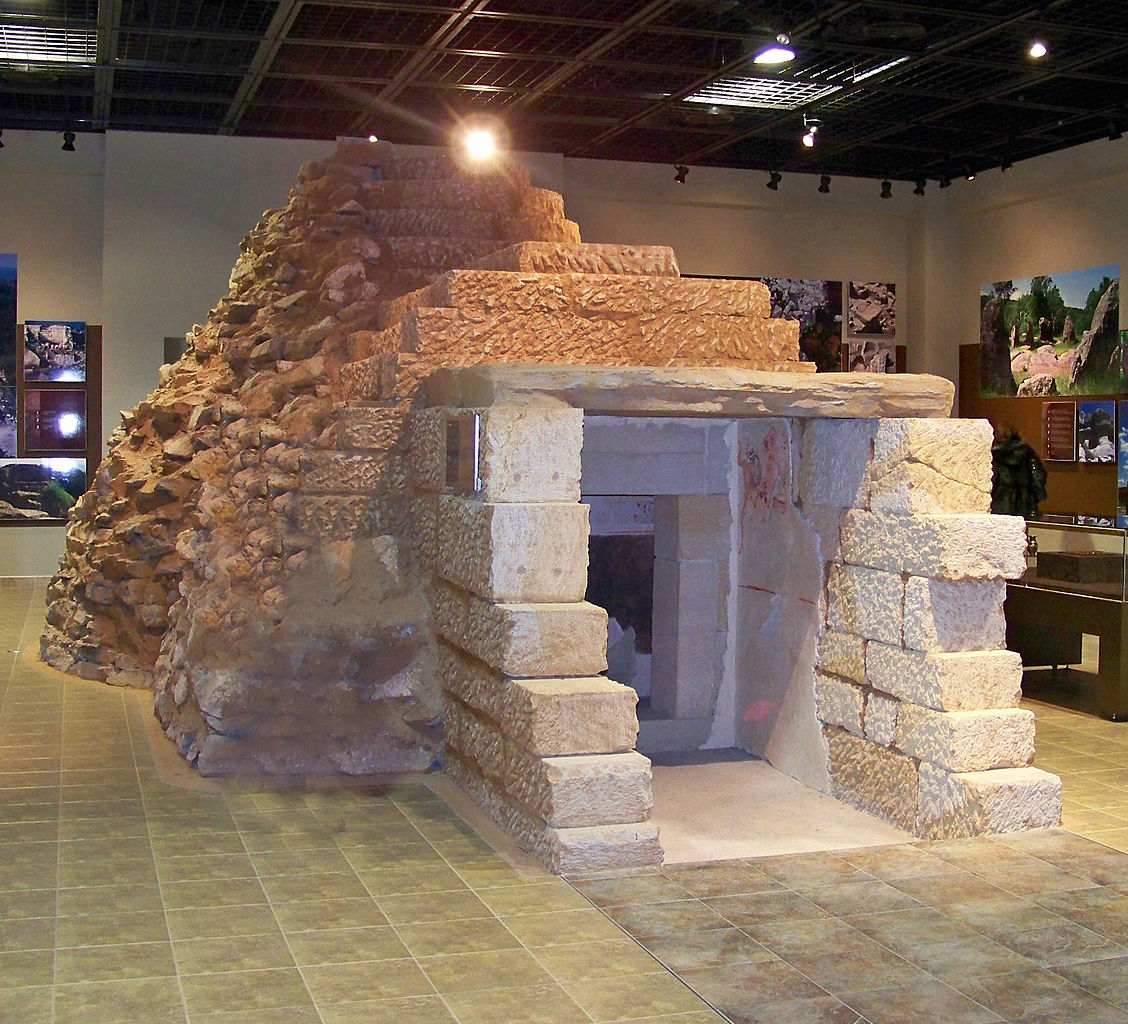
Aleksandrovo tomb, 4th century BC, Haskovo district, Bulgaria
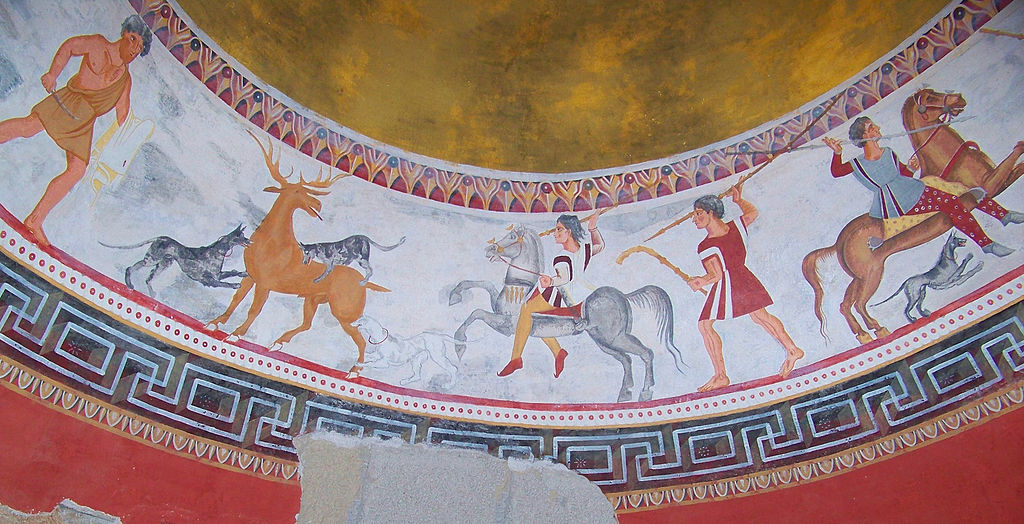
Aleksandrovo tomb, fragment of a mural, 4th century BC, 4th century BC, Haskovo district, Bulgaria

Mausoleum of the Julii, cr. 40 BC, Glanum, part of Roman Republic (now Saint-Rémy de Provence, France)

North face relief, mausoleum of the Julii, cr. 40 BC, Glanum, part of Roman Republic (now Saint-Rémy de Provence, France)

Necropolis of Naqsh-e Rostam, with two Achaemenid tombs and three Sasanian reliefs, 5th century BC and cr. 276–293, Achaemenid and Sasanian, Naqsh-e Rostam, Persia
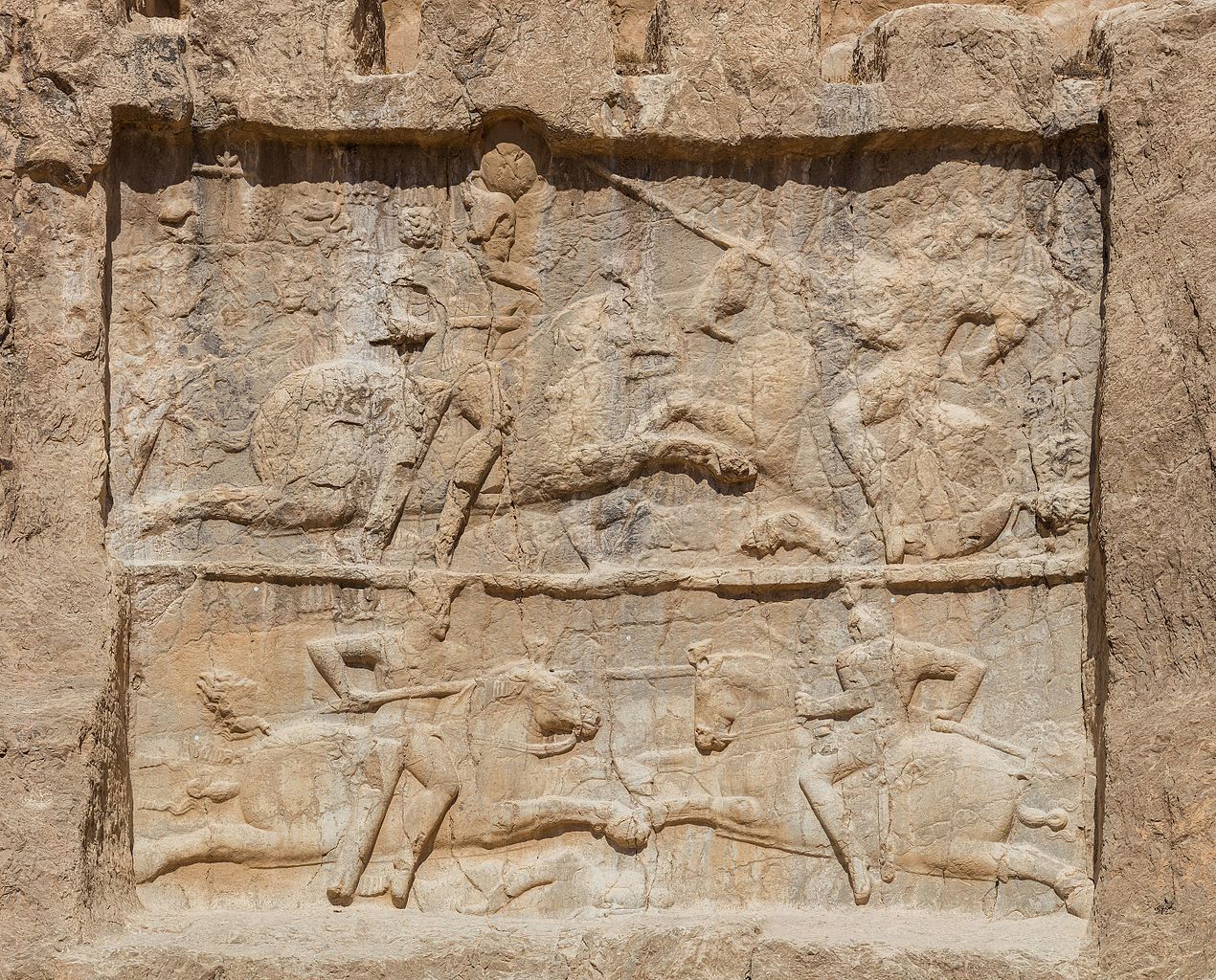
Equestrian reliefs of Bahram II, necropolis of Naqsh-e Rostam, cr. 276–293, Sasanian, Naqsh-e Rostam, Persia
History
↑ Back To Table Of Contents ↑
333 BC: Establishment of Alexander the Great’s empire and beginning of the end of Persian empire
↑ Back To Table Of Contents ↑
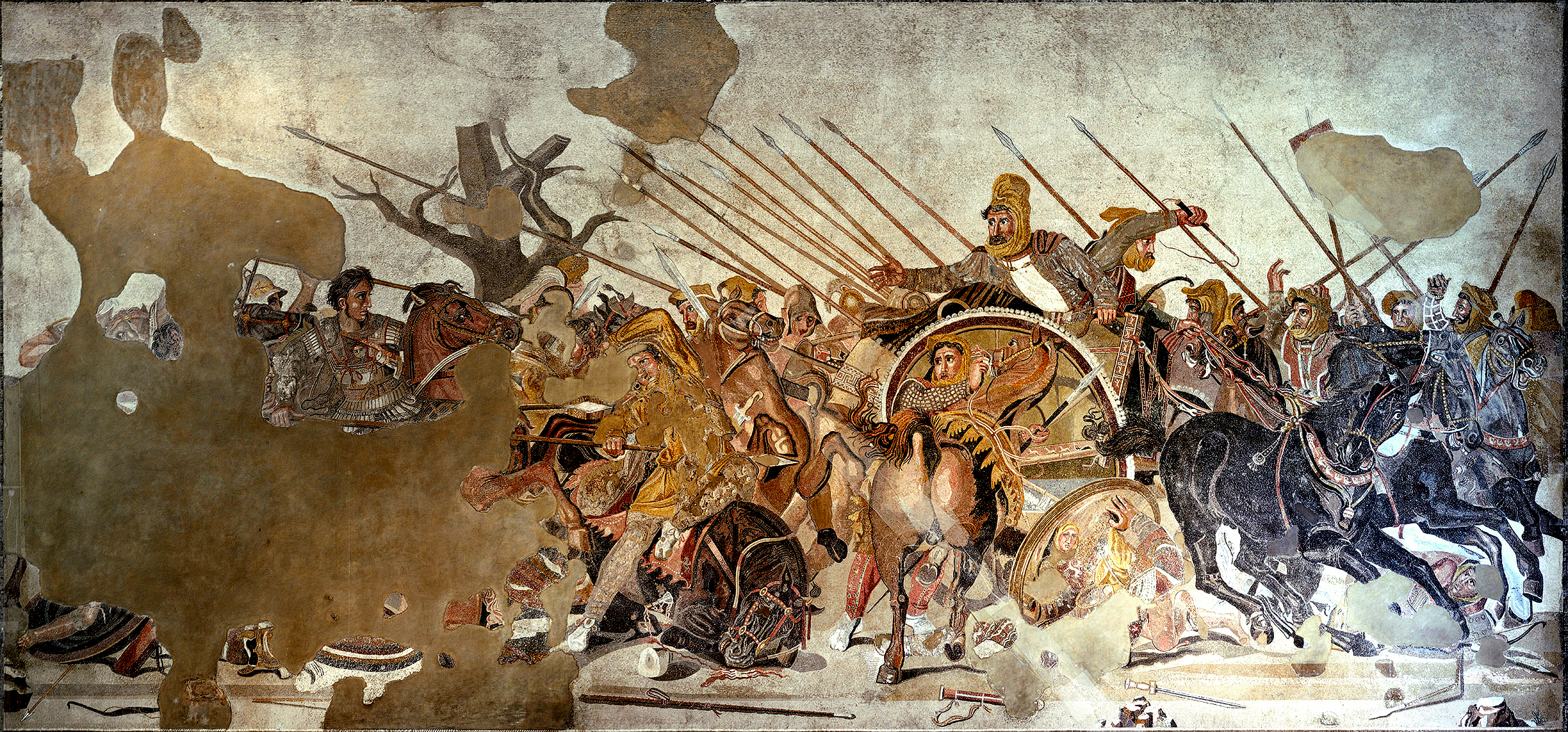
Mosaic showing the battle of Issus, circa 100 BC, Pompeii, Roman empire, perhaps after an earlier Greek painting of Philoxenus of Eretria (4th-3rd century BC)
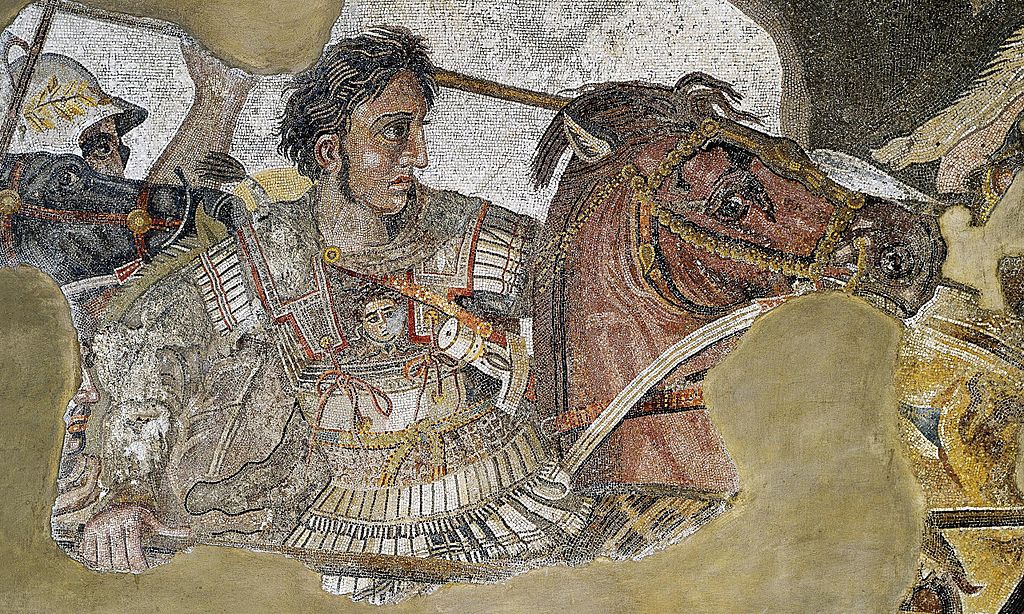
Mosaic showing the battle of Issus, detail showing Alexander the Great, circa 100 BC, Pompeii, Roman empire, perhaps after an earlier Greek painting of Philoxenus of Eretria (4th-3rd century BC)
The Battle of Issus (333 BC) was a decisive victory of
Alexander the Great and his army. It marked the beginning of the end of Persian power. It was the first time the Persian army had been defeated with the King (
Darius III) present.
323 BC: Death of Alexander the Great and beginning of the Hellenistic era
↑ Back To Table Of Contents ↑

Alexander sarcophagus, long side showing the battle of Issus, circa 320 BC, Ionian or Rhodian workmanchip, Hellenistic

Alexander sarcophagus, long side showing a lion hunt, with (l-r) Hephaestion, Abdalonymos and Alexander the Great, circa 320 BC, Ionian or Rhodian workmanchip, Hellenistic
The death of
Alexander the Great in 323 BC resulted in dissolution of his empire and gave way to multipolar
Hellenistic world.
31 BC: Beginning of the Roman Imperial era
↑ Back To Table Of Contents ↑

Aureus showing Augustus on horseback on reverse, minted in 32-29 BC under Augustus, the last type to be issued before the Battle of Actium, Roman Empire
This aureus was struck under the future emperor
Augustus, probably in preparation for the inevitable confrontation with Antony, the last type to be issued before the
Battle of Actium (31 BC).
Augustus won this battle and became first emperor of the
Roman Empire.
Mark Antony and
Cleopatra were defeated and committed suicide. The
Battle of Actium marks the end of the
Hellenistic period with its multipolar world structure, and marked the beginning of an era of the dominance of the Roman Empire known as the
Pax Romana.
312 and 1520: Beginning of the Christian era of the Roman empire and transition from renaissance to mannerism
↑ Back To Table Of Contents ↑
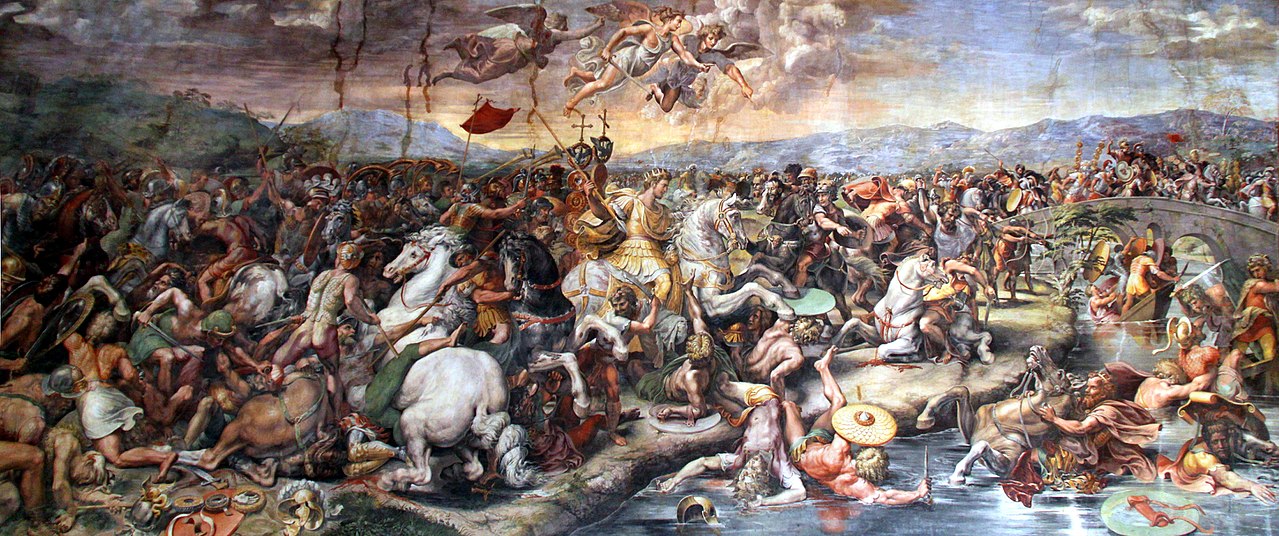
The Battle of the Milvian Bridge, 1520-4, Giulio Romano, designed by Raphael, Vatican, Italy
The
Battle of the Milvian Bridge took place between the Roman Emperors
Constantine I and
Maxentius in 312. It takes its name from the
Milvian Bridge, an important route over the Tiber. Constantine won the battle and started on the path that led him to end the
Tetrarchy and become the sole ruler of the Roman Empire. According to chroniclers, the battle marked the beginning of Constantine’s conversion to Christianity.
Some historians view 1520, the date of the death of Raphael, as the end of Renaissance and beginning of a new art style, Mannerism, also known as Late Renaissance. Raphael is viewed as zenith of High Renaissance, and it was his head assistant, Giulio Romano, along with Parmigianino who launched Mannerism! Thus, the fresco below can be viewed as a turning point of art: it was designed by the youngest of prominent High Renaissance artists, Raphael, and completed by a pioneer of Mannerism, Giulio Romano.
1066: Norman conquest of England
↑ Back To Table Of Contents ↑
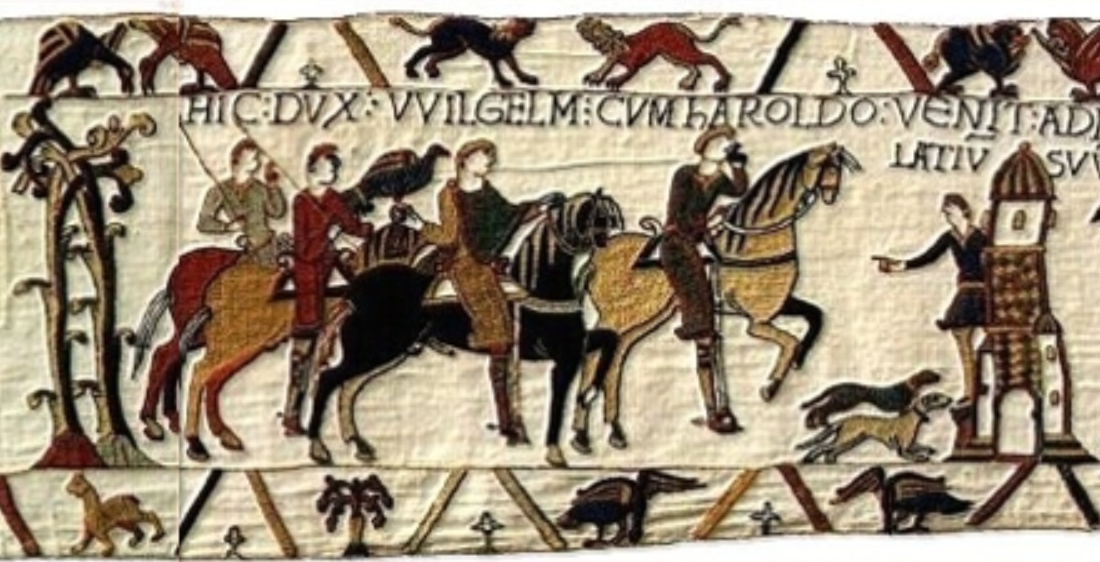
Bayeux Tapestry, France, probably 1070s
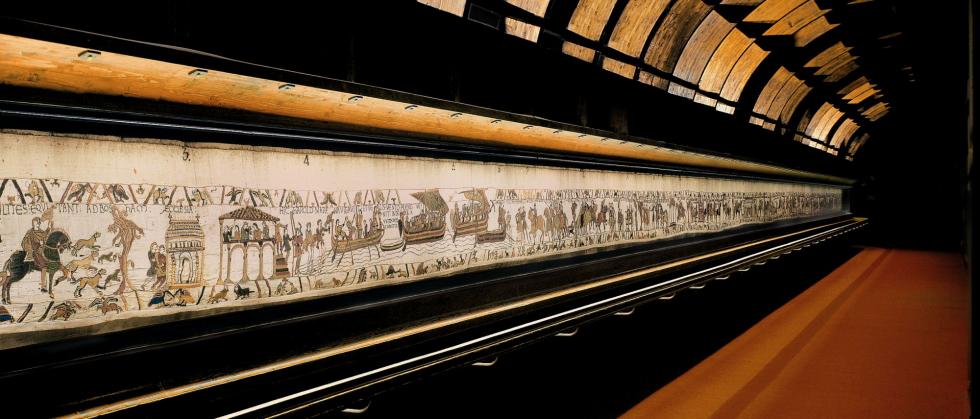
Bayeux Tapestry, France, probably 1070s
Bayeux Tapestry is one of a kind, cr. 70 metres long, narrative embroidery depicting the events leading up to the Norman conquest of England, and culminating in the
Battle of Hastings. It is probable that it was created in the 1070s for
Odo of Bayeux, the Earl of Kent and Bishop of
Bayeux, who was the half-brother of
William the Conqueror.
1453: The fall of Constantinople
↑ Back To Table Of Contents ↑

Fall of Constantinople (1453), 1932, Theophilos Hatzimihail, Greece
The Byzantine Empire fell to the rising Ottoman Sultanate in the fall of Constantinople in 1453.
1648: The last major battle of the Religious Wars
↑ Back To Table Of Contents ↑

Battle of Lens (1648), cr. 1835, Pierre Franque, Galerie des Batailles, Versailles, France
The
Battle of Lens that took place in 1648 was the last major battle of the
Thirty Years' War (1618–1648) and of the
European wars of religion (1522-1648). The
Peace of Westphalia marked the end of the age of European empired and beginning of the era of European nation-states.
1709: Establishment of the Russian empire and beginning of the end of the Swedish empire
↑ Back To Table Of Contents ↑
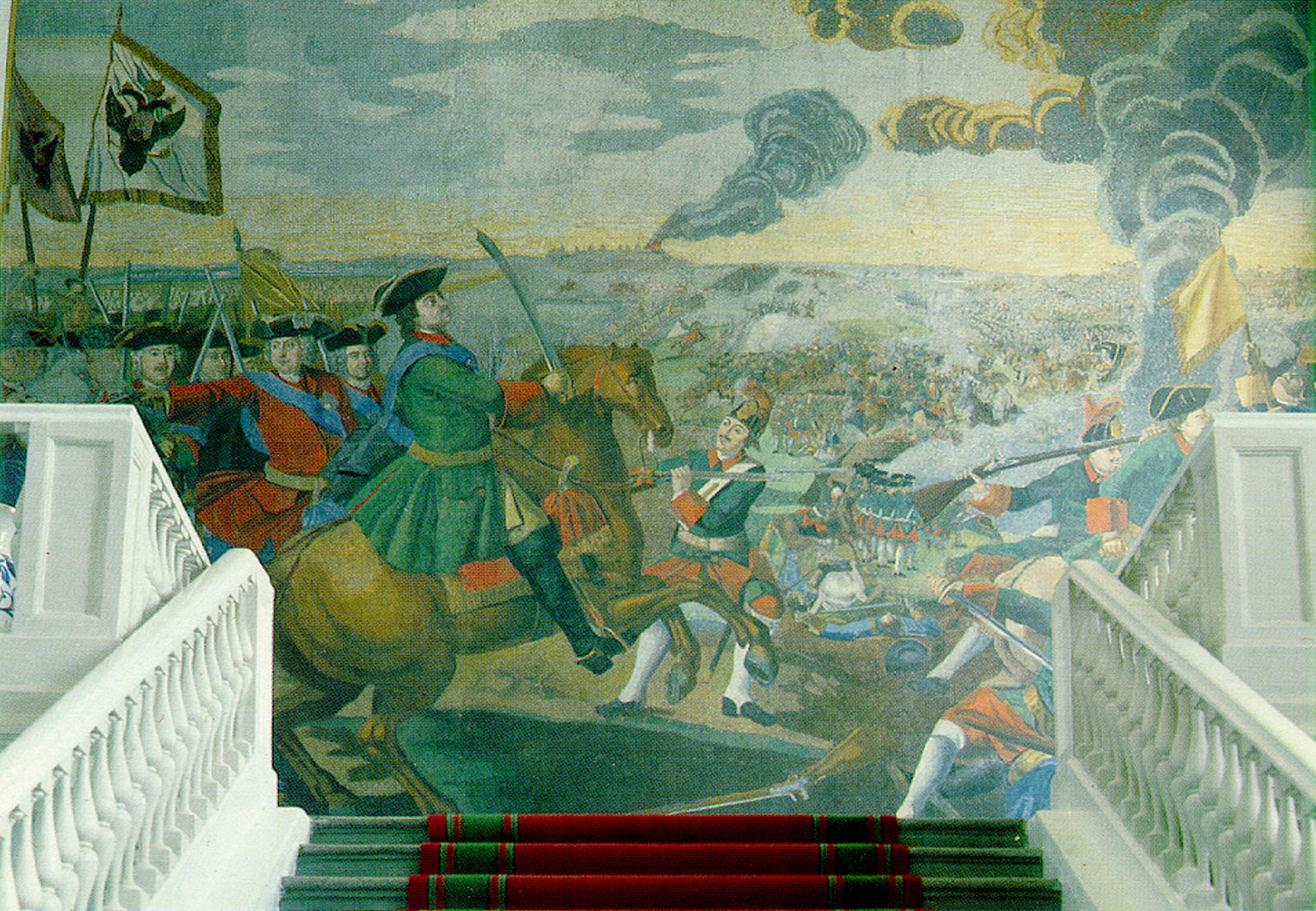
Battle of Poltava (mosaic), 1762–1764, Mikhail Lomonosov
This mosaic depicts the
Battle of Poltava (1709), the decisive battle of the
Great Northern War. The outcome of this battle the beginning of the Swedish Empire’s decline as a European great power. It shows
Peter the Great (1672-1725), the first Russian emperor, on a rearing horse. The mosaic that shows this battle was made by
Mikhail Lomonosov (1711 – 1765), one of the first notable Russian scholars.
1791: The last absolutist king of France wearing republican tricolour cockade
↑ Back To Table Of Contents ↑

Louis XVI as a citizen-king, sporting the tricolour cockade on his hat, 1791, Jean Baptiste François Carteaux
This portrait shows
Louis XVI of France after the
French Revolution of 1789, but while he was still the king of France (until 1792).





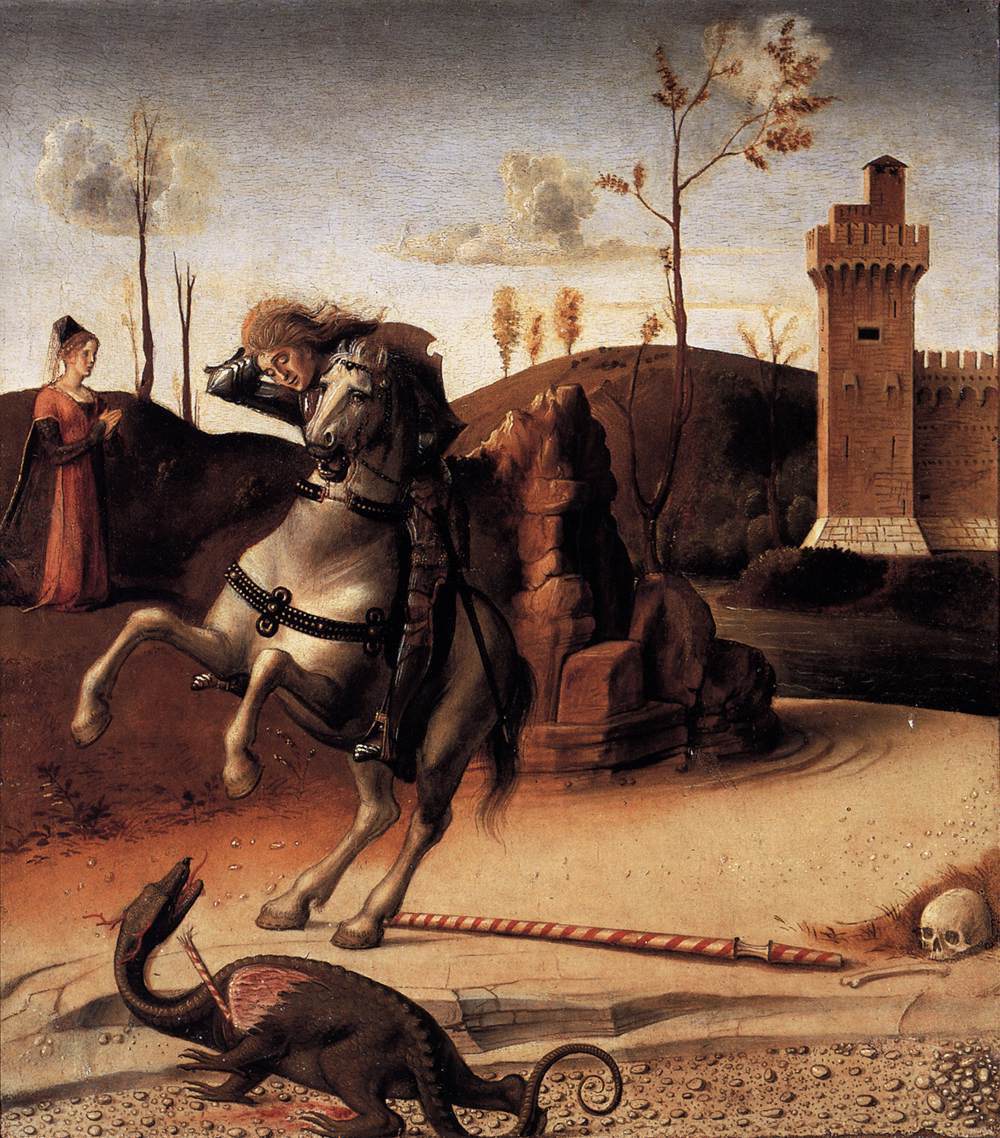

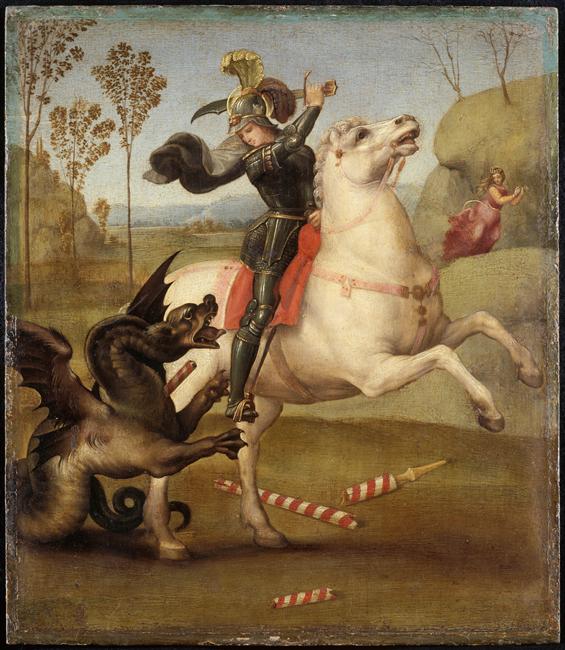









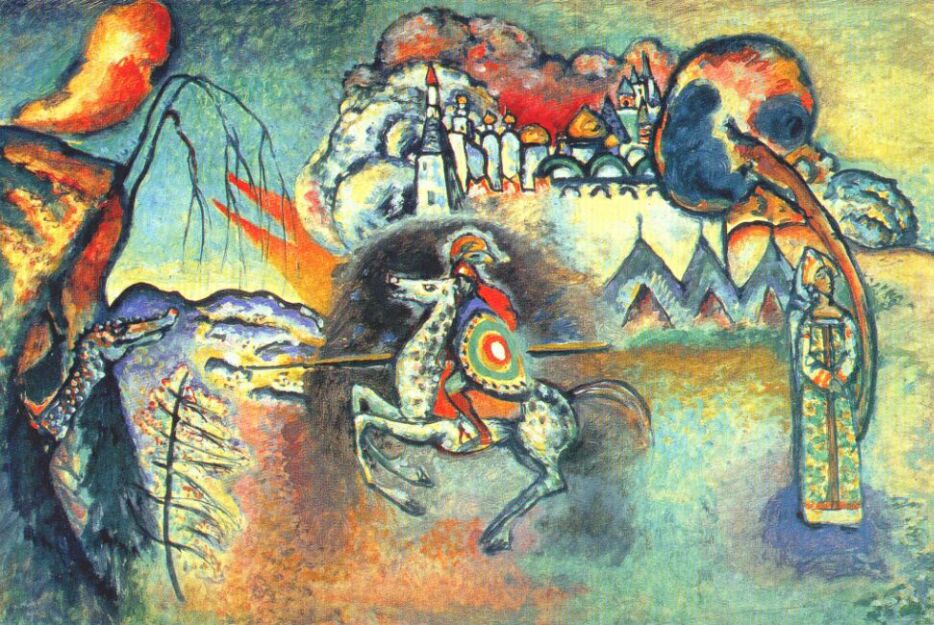


















































Leave a Reply